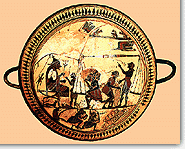

 |
|
|
After the Messenian defeat in the 1st Messenian War, the Spartans shared the land out into three thousand allotments, and turned the inhabitants of Stenyclarus into helots, in other words dependent peasants. They were obliged to swear an oath that they would not revolt and were under the imposition of handing over half their yield to the  Spartans and attending funerals of kings and other archons wearing black. After Sparta was defeated by Argos at Hysiae, in the mid-7th century, the Messenians revolted. The 2nd Messenian War lasted thirty years. The revolting Messenians received reinforcements from Argos and Pisa, organized in keeping with the new tactic of the phalanx, as we know from Tyrtaeus, who probably fought in this war; later, the Arcadians also joined in. The critical situation in which Sparta found herself from the opposing coalition was intensified by her population's attitude, with their demands for allotment redistribution. To deal with the crisis, the Spartans are traditionally said to have called in Lycurgus to draft new laws. In the final phase of the war, with the Messenians defending their stronghold on mount Eira, Elis, Corinth and the Samian fleet joined in on the Spartan side. After its fall, many Messenians took refuge in cities in Arcadia, in Pylos and in Methone; from whence a number emigrated to the colonies of the West. The Spartans razed Pylos to the ground at the end of the 7th century, and settled the inhabitants of Nauplium in Methone - sacked by Argos - as perioeci. The quality and spread of Laconian articles in pottery and bronze at the start of the 6th century gives a good indication of Sparta's acme after the end of the Messenian wars; and it was in fact in the middle of this same century that she went ahead with the founding of the Peloponnesian alliance.
Spartans and attending funerals of kings and other archons wearing black. After Sparta was defeated by Argos at Hysiae, in the mid-7th century, the Messenians revolted. The 2nd Messenian War lasted thirty years. The revolting Messenians received reinforcements from Argos and Pisa, organized in keeping with the new tactic of the phalanx, as we know from Tyrtaeus, who probably fought in this war; later, the Arcadians also joined in. The critical situation in which Sparta found herself from the opposing coalition was intensified by her population's attitude, with their demands for allotment redistribution. To deal with the crisis, the Spartans are traditionally said to have called in Lycurgus to draft new laws. In the final phase of the war, with the Messenians defending their stronghold on mount Eira, Elis, Corinth and the Samian fleet joined in on the Spartan side. After its fall, many Messenians took refuge in cities in Arcadia, in Pylos and in Methone; from whence a number emigrated to the colonies of the West. The Spartans razed Pylos to the ground at the end of the 7th century, and settled the inhabitants of Nauplium in Methone - sacked by Argos - as perioeci. The quality and spread of Laconian articles in pottery and bronze at the start of the 6th century gives a good indication of Sparta's acme after the end of the Messenian wars; and it was in fact in the middle of this same century that she went ahead with the founding of the Peloponnesian alliance.
|
| |
|
Note: Click on pictures to see a short description. | |